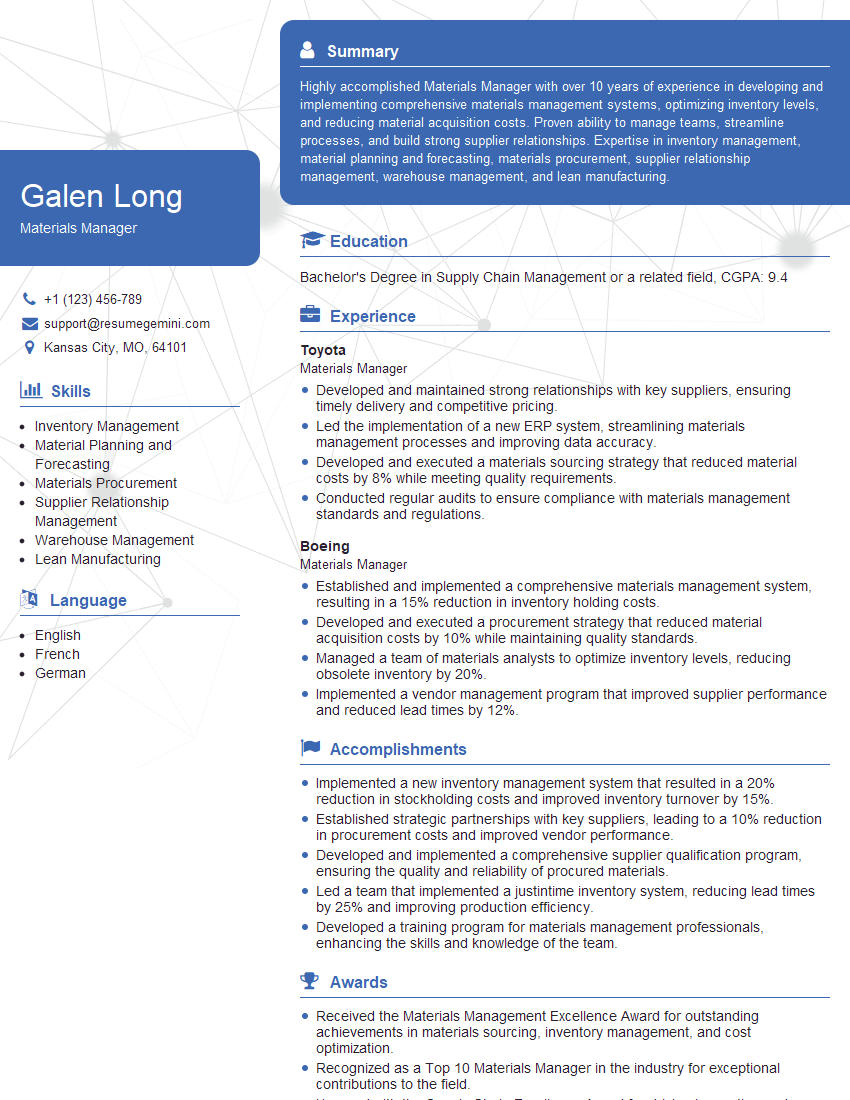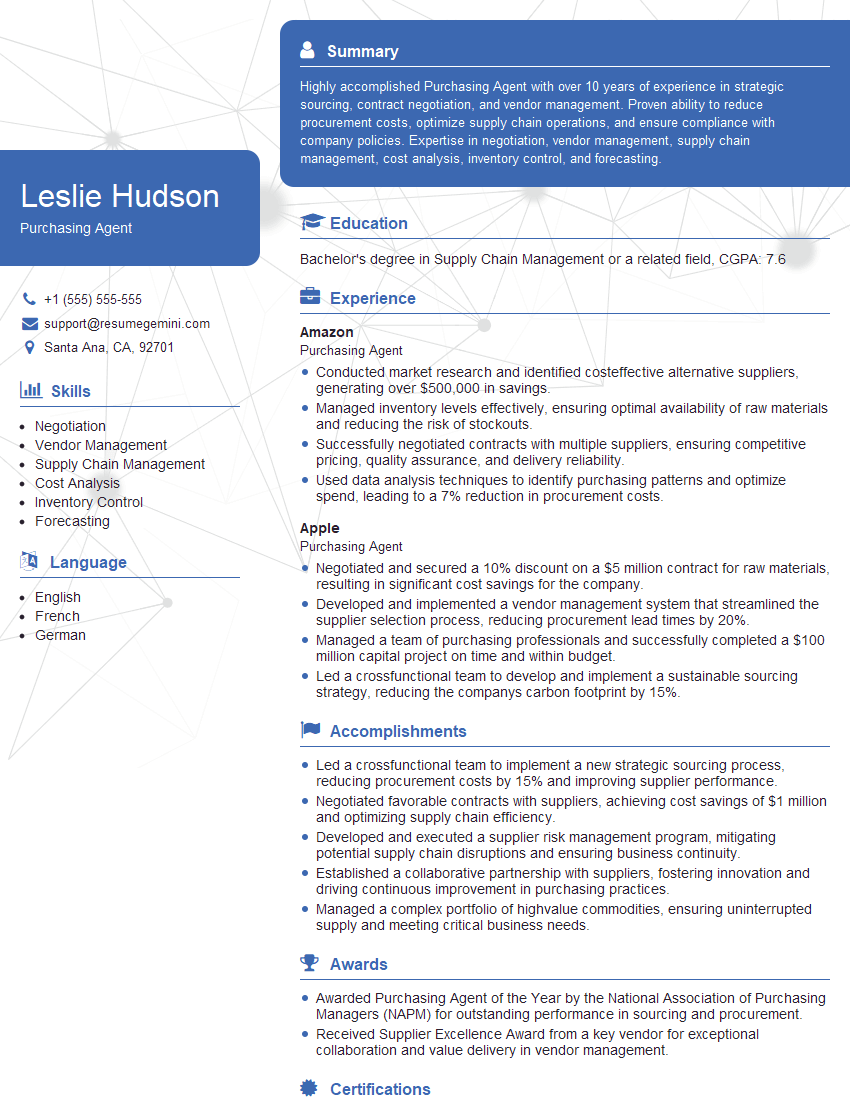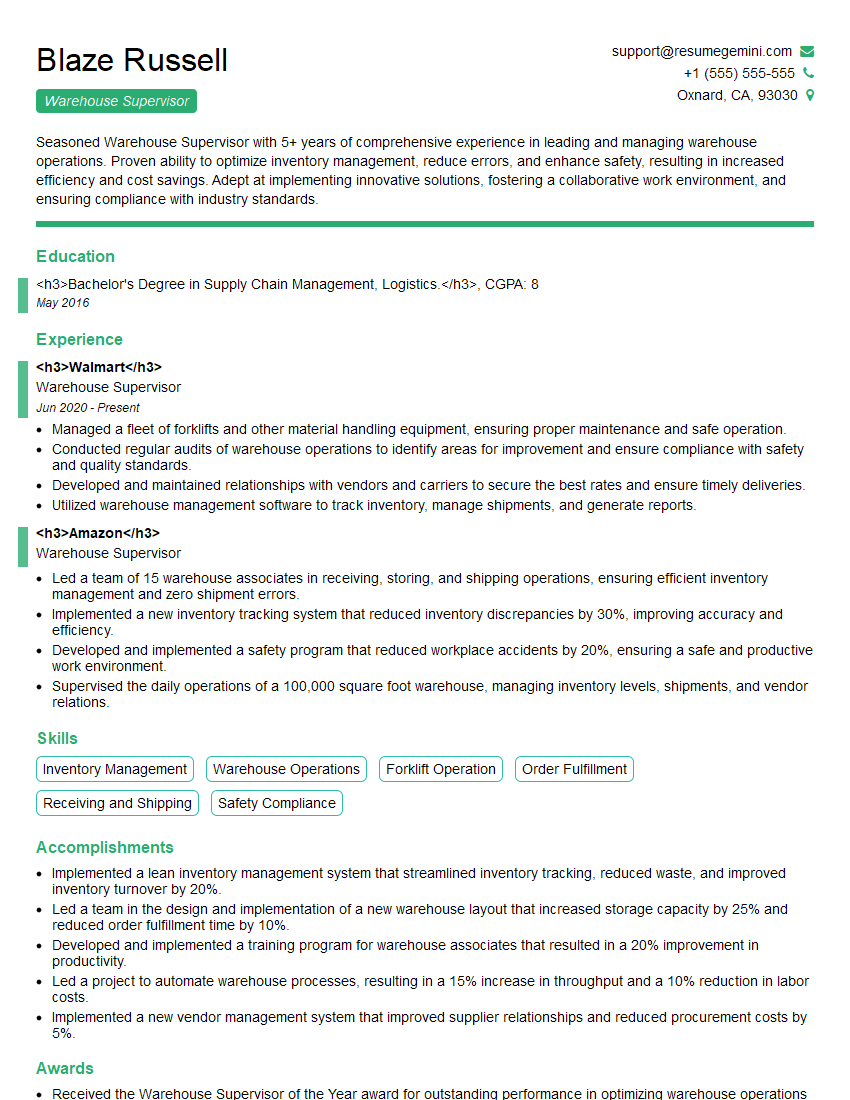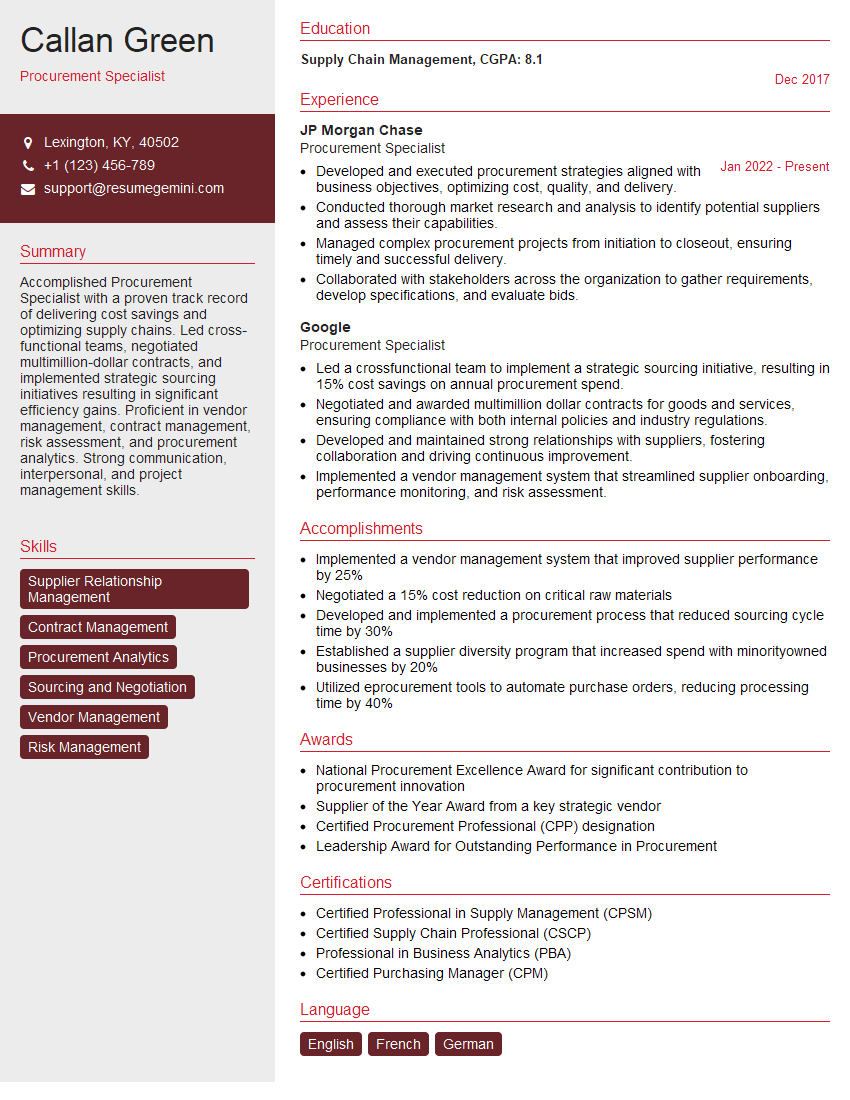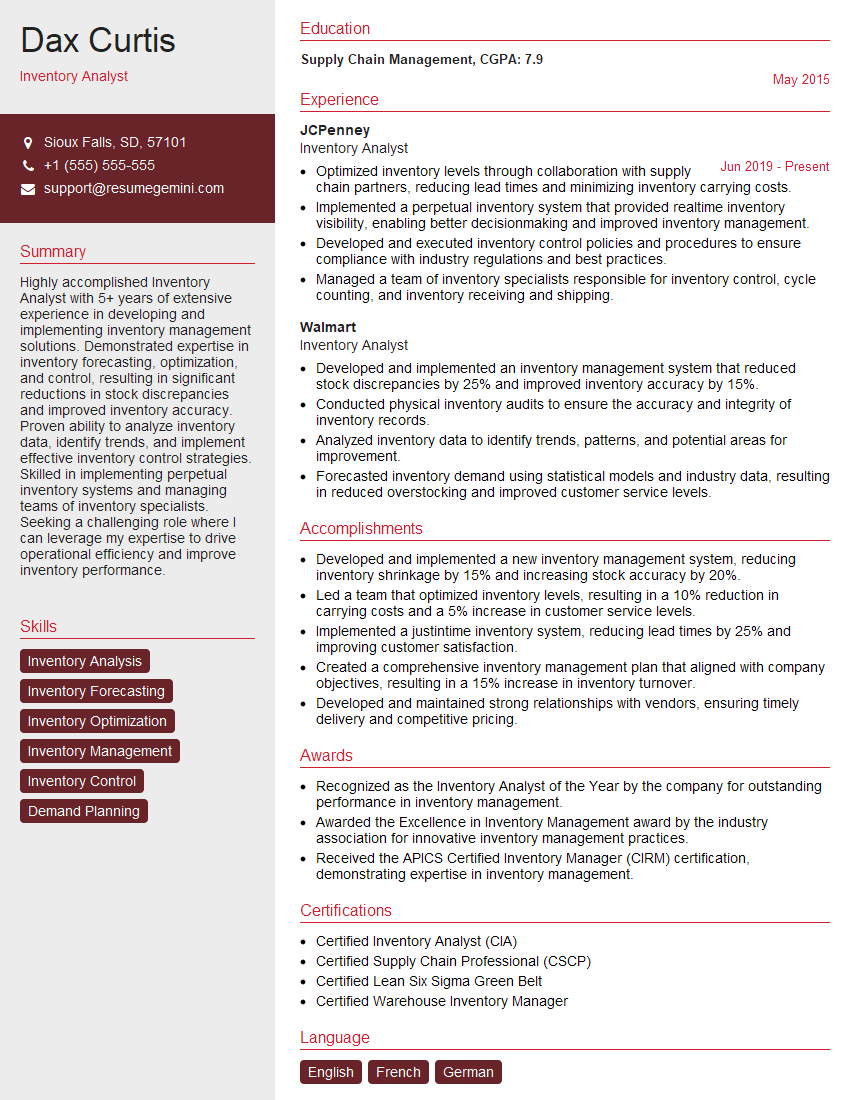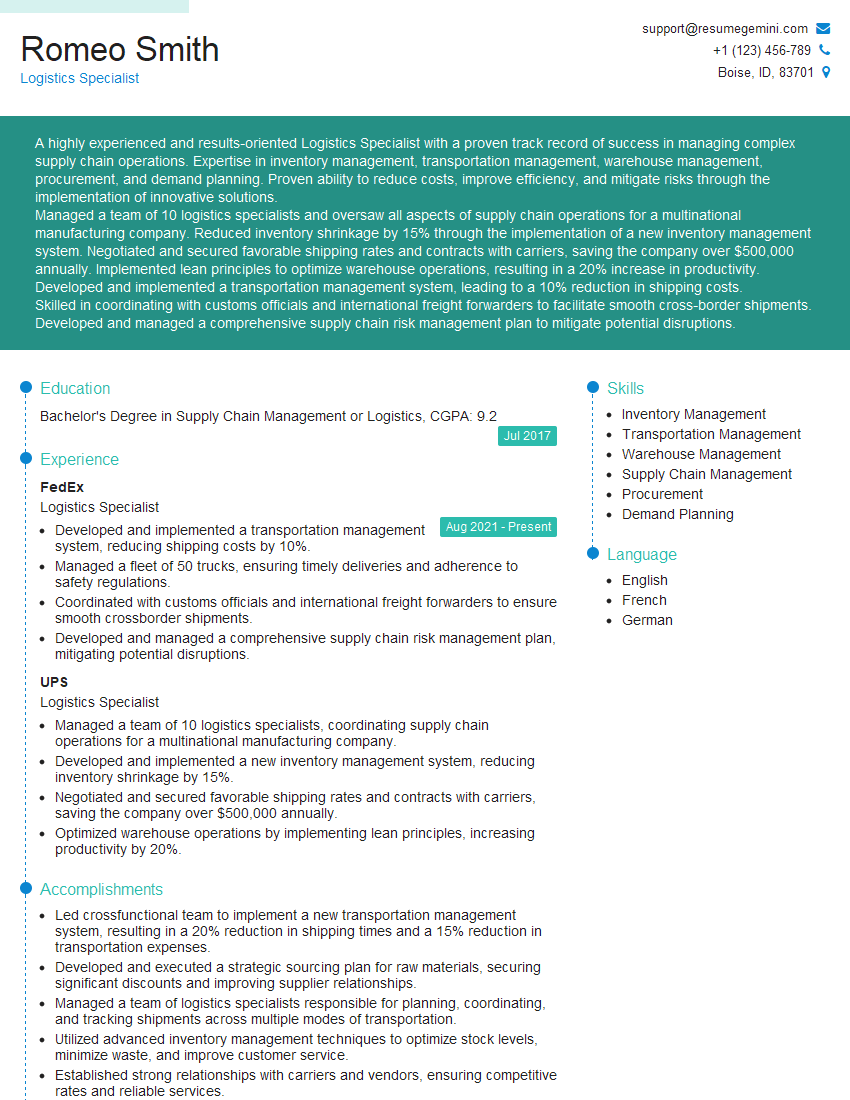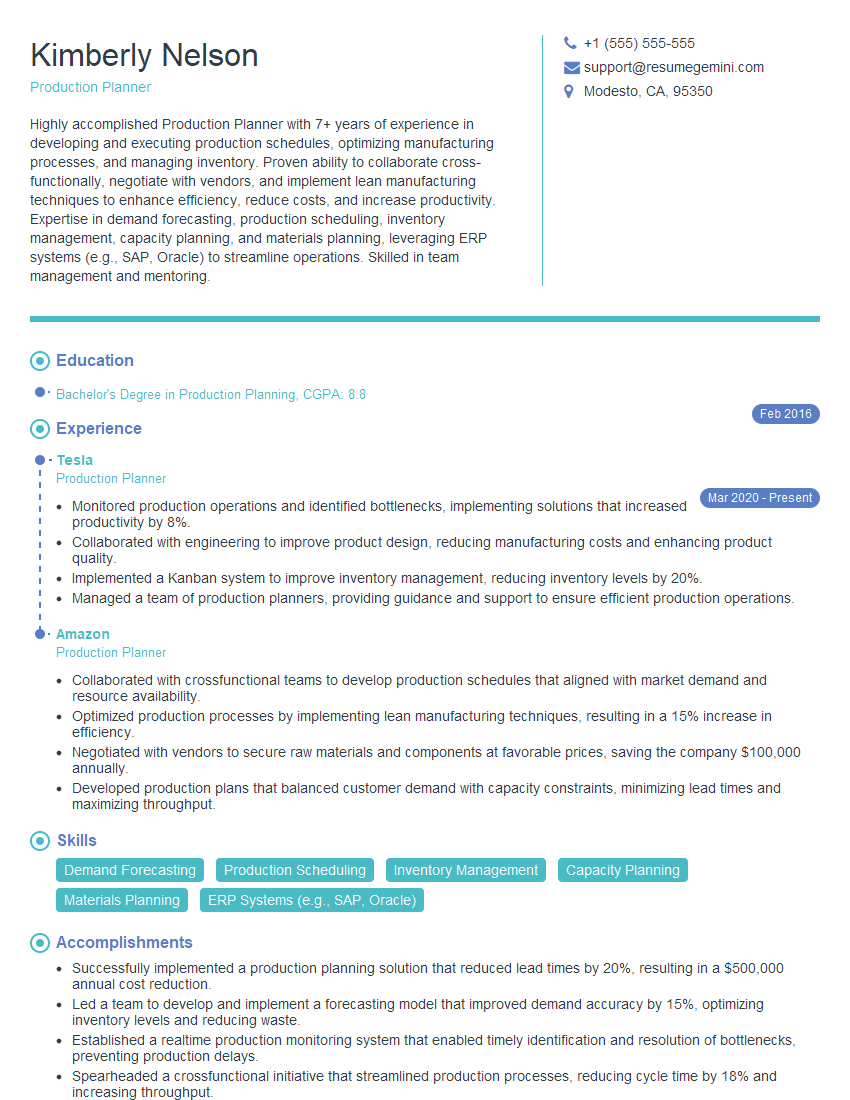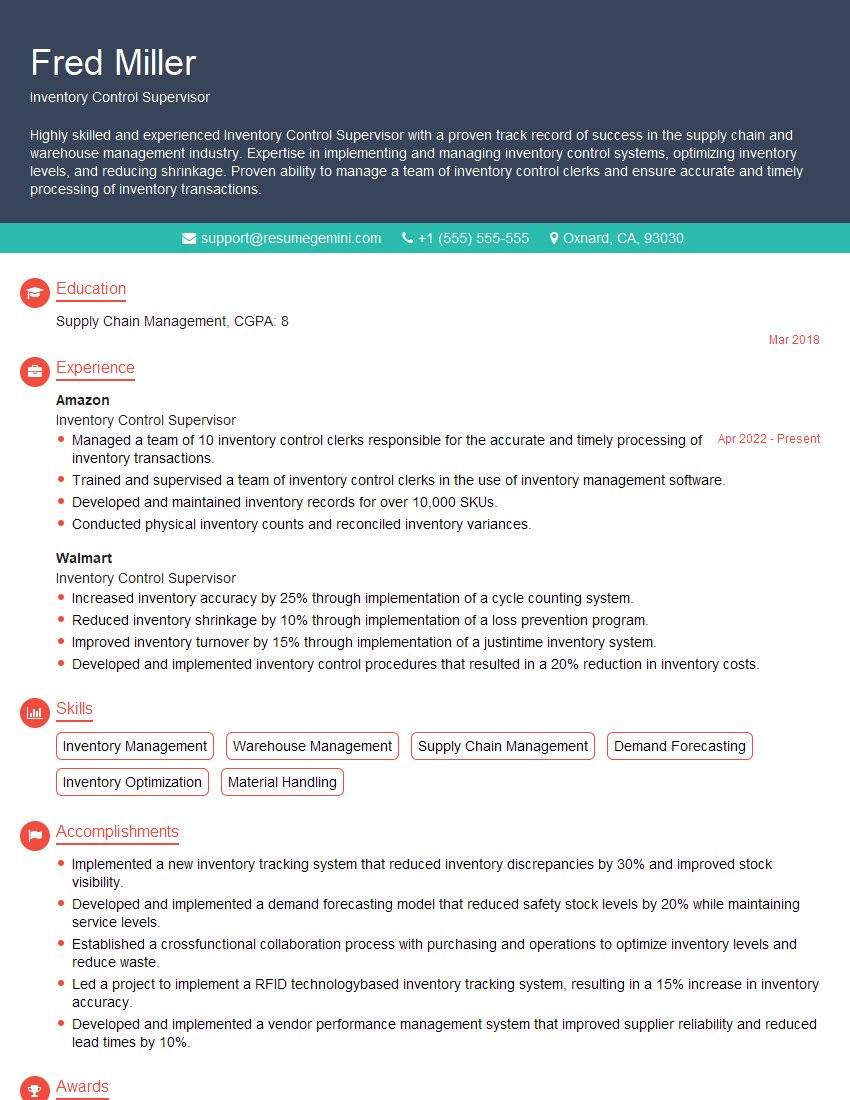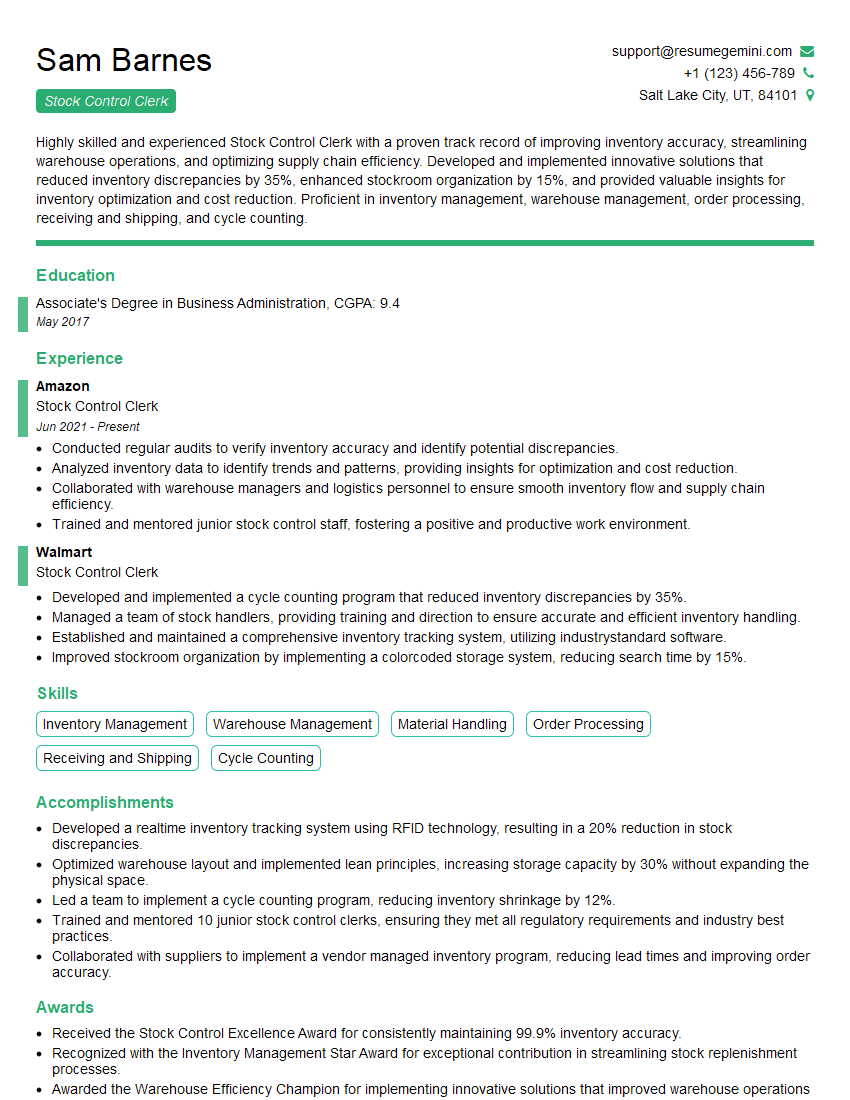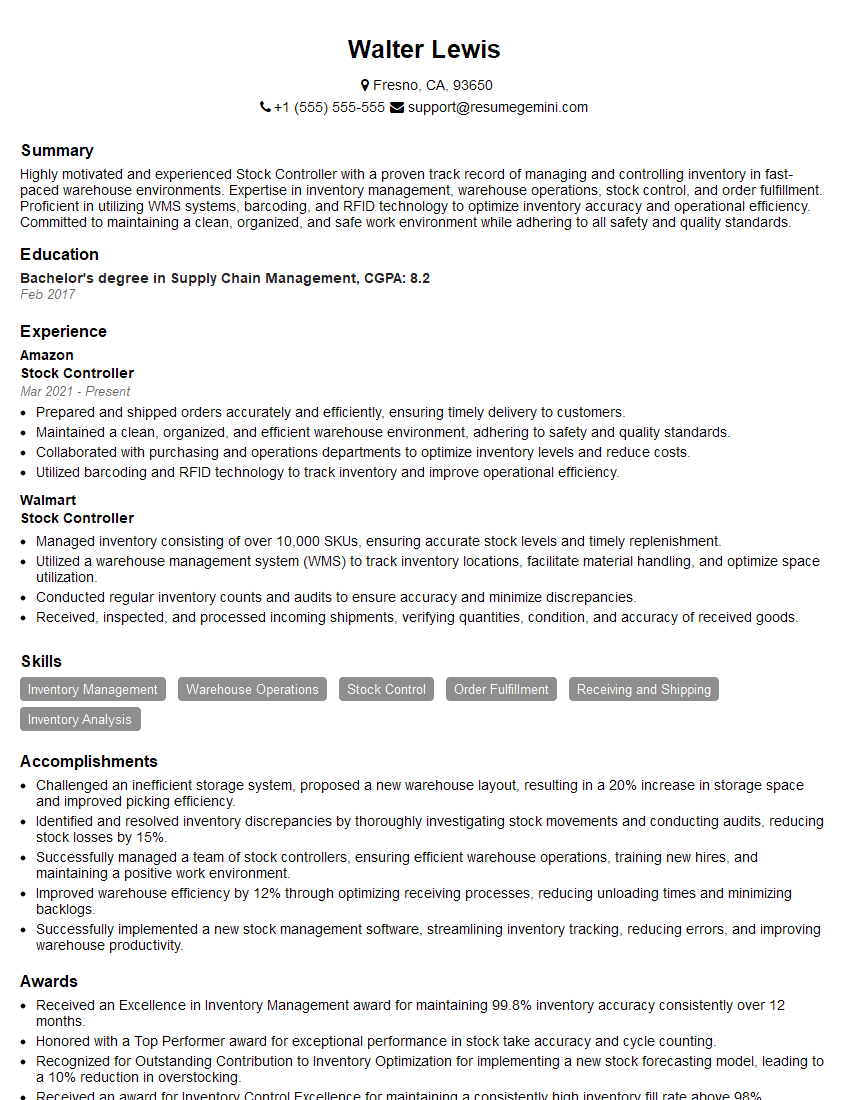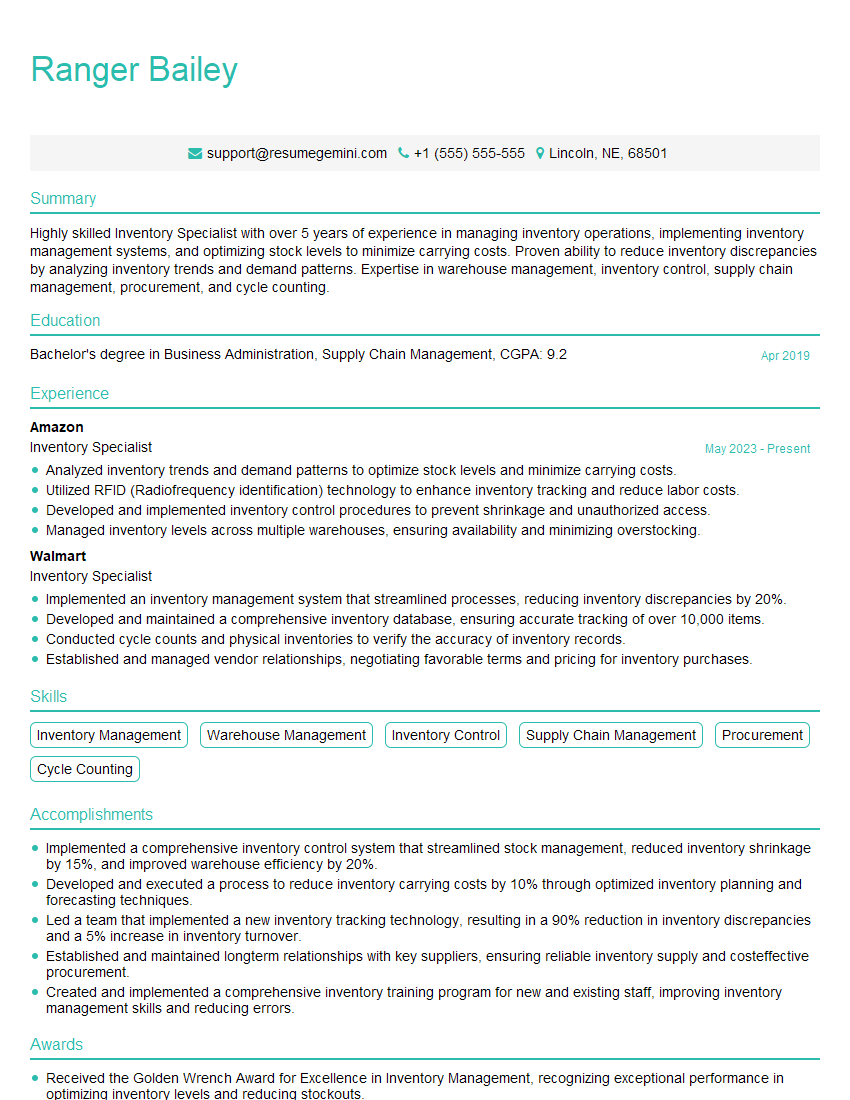Interviews are more than just a Q&A session—they’re a chance to prove your worth. This blog dives into essential Use inventory control procedures interview questions and expert tips to help you align your answers with what hiring managers are looking for. Start preparing to shine!
Questions Asked in Use inventory control procedures Interview
Q 1. Explain the different methods of inventory valuation (FIFO, LIFO, weighted average).
Inventory valuation methods determine the cost of goods sold and the value of ending inventory. Three common methods are FIFO (First-In, First-Out), LIFO (Last-In, First-Out), and Weighted Average Cost.
- FIFO: This assumes that the oldest items are sold first. Imagine a bakery; the first loaves of bread baked are the first ones sold. This method results in a higher net income during periods of inflation because the cost of goods sold is lower (based on older, cheaper inventory).
- LIFO: This assumes that the newest items are sold first. Think of a stack of pancakes – you eat the top one (the last one added) first. During inflation, LIFO results in a lower net income because the cost of goods sold is higher (based on newer, more expensive inventory). Note: LIFO is not permitted under IFRS (International Financial Reporting Standards).
- Weighted Average Cost: This method calculates the average cost of all items in inventory. It’s like calculating your average grade – you add up all your scores and divide by the number of scores. This method smooths out fluctuations in cost and is simpler to calculate than FIFO or LIFO.
Example: Let’s say you purchased 10 units at $10 each and later 20 units at $12 each. Under FIFO, the cost of goods sold for 15 units would be (10 units * $10) + (5 units * $12) = $160. Under LIFO, it would be (20 units * $12) + (5 units * $10) = $290. The weighted average cost would be (($10 * 10) + ($12 * 20)) / 30 = $11.33 per unit, making the cost of goods sold for 15 units $170 (approximately).
Q 2. Describe your experience with inventory control software (e.g., SAP, Oracle).
I have extensive experience with enterprise-level inventory control software, primarily using SAP and Oracle. In my previous role at [Previous Company Name], I was responsible for configuring and maintaining SAP’s Materials Management (MM) module. This included setting up material masters, managing inventory transactions, and generating reports for inventory analysis. I’ve used the system to track everything from raw materials to finished goods, ensuring data accuracy and timely updates.
With Oracle, my experience focused on inventory optimization and forecasting. I worked with the system to analyze historical data, predict future demand, and optimize inventory levels to minimize storage costs and prevent stockouts. I also have experience implementing and integrating these systems with other enterprise resource planning (ERP) modules, like production planning and financial accounting, facilitating a seamless flow of information across the organization.
My expertise extends beyond basic data entry and reporting. I’m proficient in developing custom reports and utilizing advanced analytical features within both systems to identify areas for process improvement and cost reduction. For instance, I developed a custom report in SAP that pinpointed slow-moving inventory items, leading to a 15% reduction in obsolete stock within six months.
Q 3. How do you identify and address inventory discrepancies?
Identifying and addressing inventory discrepancies is crucial for maintaining accurate records and optimizing operations. My approach involves a multi-pronged strategy combining regular cycle counting, robust data reconciliation, and investigation of root causes.
- Cycle Counting: Regularly counting a small subset of inventory items instead of a full inventory count helps catch discrepancies early. This is more efficient than annual physical counts.
- Data Reconciliation: Comparing physical counts with the inventory management system’s records identifies variances. This involves meticulous investigation to determine if the difference is due to data entry errors, theft, damage, or other issues.
- Root Cause Analysis: Once a discrepancy is identified, I investigate the underlying cause. This might involve reviewing warehouse procedures, checking for damaged goods, or even considering the possibility of theft. Addressing the root cause prevents future occurrences.
Example: If a cycle count reveals a shortage of a specific item, I would first verify the accuracy of the count itself. Then, I would cross-reference the inventory system for any discrepancies in recent transactions (receipts, shipments). If these don’t explain the shortage, I’d investigate potential causes like damage, theft, or misplacement, implementing corrective actions to prevent similar incidents in the future. This might involve improving warehouse organization, implementing stricter security measures, or updating procedures for handling inventory.
Q 4. What are the key performance indicators (KPIs) you use to monitor inventory performance?
Several key performance indicators (KPIs) are vital for monitoring inventory performance. These provide insights into efficiency, cost, and customer service levels.
- Inventory Turnover Ratio: This measures how many times inventory is sold and replaced within a specific period. A higher ratio generally indicates efficient inventory management.
- Days Sales of Inventory (DSI): Indicates the number of days it takes to sell inventory. A lower DSI suggests efficient inventory flow.
- Inventory Holding Cost: Represents the cost of storing and managing inventory, including warehousing, insurance, and obsolescence. Minimizing this cost is crucial.
- Stockout Rate: The percentage of times an item is out of stock when demanded. A high stockout rate impacts customer satisfaction and sales.
- Fill Rate: The percentage of customer orders fulfilled on time and in full. A higher fill rate demonstrates efficient order fulfillment.
By tracking these KPIs, I can identify areas for improvement and make data-driven decisions to optimize inventory management. For example, a high inventory holding cost might indicate overstocking, while a high stockout rate suggests insufficient inventory levels. Analyzing these metrics allows for proactive adjustments to inventory policies.
Q 5. How do you manage obsolete or slow-moving inventory?
Managing obsolete or slow-moving inventory requires a proactive approach to minimize losses. My strategy involves several steps:
- Identification: Regularly analyze inventory data to identify items that haven’t moved in a specified period. This often involves ABC analysis, which categorizes inventory based on value and usage.
- Price Reduction/Discounts: Offering discounts or promotional pricing can help move slow-moving items. This could involve sales, clearance events, or special bundles.
- Repurposing/Refurbishing: In some cases, slow-moving items can be repurposed or refurbished for sale. For example, slightly damaged goods might be sold at a lower price.
- Donation/Disposal: As a last resort, obsolete inventory might be donated to charity or disposed of appropriately, depending on regulations and the nature of the goods. Proper documentation is crucial for tax purposes.
- Inventory Review Meetings: Regular meetings with sales, purchasing, and marketing teams help review inventory data and identify strategies for moving slow-moving items. Collaborative problem-solving is key.
For example, I once managed a situation where a significant amount of seasonal inventory remained unsold after the season ended. By working with the marketing team to create a special post-season sale and offering significant discounts, we successfully moved most of the remaining stock, minimizing losses.
Q 6. Explain the importance of cycle counting and its frequency.
Cycle counting is a crucial inventory control procedure involving regularly counting a subset of inventory items rather than a full physical inventory count. It helps maintain inventory accuracy, prevent large discrepancies, and reduce the time and resources needed for a full inventory count.
The frequency of cycle counting depends on several factors, including the value and velocity of inventory items, the risk of loss or damage, and the accuracy of the inventory management system. High-value or fast-moving items usually require more frequent counting (e.g., daily or weekly), while low-value or slow-moving items can be counted less often (e.g., monthly or quarterly).
Benefits of Cycle Counting:
- Improved Inventory Accuracy: Regular counts reduce the likelihood of large discrepancies between physical inventory and records.
- Reduced Downtime: Cycle counting is less disruptive than a full inventory count, minimizing disruptions to operations.
- Early Detection of Issues: Discrepancies are identified and addressed promptly, preventing larger problems later.
- Better Inventory Management: Continuous monitoring of inventory levels allows for better management of stock levels.
For example, a warehouse with a high turnover of expensive electronics might implement a daily cycle counting schedule for those items. Meanwhile, a warehouse with mostly slow-moving, low-value items might choose a monthly or quarterly cycle counting schedule.
Q 7. Describe your experience with barcode scanning and RFID technology.
I have extensive experience with barcode scanning and RFID (Radio-Frequency Identification) technology in inventory management. Barcode scanning is a mature technology that provides a relatively low-cost and efficient way to track individual items. I’ve used handheld barcode scanners in numerous warehouse environments to track inventory movements, receive goods, and update inventory records in real-time.
RFID technology offers a more advanced solution with greater capabilities. Unlike barcodes that require line-of-sight scanning, RFID tags can be read remotely, enabling faster and more efficient inventory tracking. In a previous role, I was involved in the implementation of an RFID system for tracking high-value pharmaceuticals. This significantly improved inventory accuracy, reduced stockouts, and streamlined the entire process from receiving to shipping. The system could automatically track the location and movement of each item, providing a comprehensive view of inventory levels and preventing losses.
The choice between barcode scanning and RFID depends on various factors including budget, item characteristics, and the desired level of accuracy and automation. Barcode scanning remains suitable for many applications, especially where cost-effectiveness is a key consideration. However, RFID offers superior capabilities when real-time visibility, accuracy, and automation are paramount.
Q 8. How do you ensure inventory accuracy?
Ensuring inventory accuracy is paramount for efficient operations and profitability. It’s achieved through a multi-faceted approach combining robust systems and diligent practices. Think of it like keeping a meticulously organized and updated recipe book for your business – if the ingredients (inventory) are wrong, the final product (your service or goods) suffers.
- Regular Cycle Counting: Instead of a large, disruptive annual inventory count, we conduct smaller, frequent cycle counts. This means regularly verifying the physical count of specific items against the system record. For example, we might count all items in aisle 3 every Monday. This allows for quicker identification and correction of discrepancies.
- Barcode/RFID Scanning: Using barcode or RFID scanners significantly reduces manual data entry errors and speeds up the counting process. Every item is quickly and accurately tracked.
- Inventory Management System (IMS): Implementing a robust IMS is crucial. This system provides a central hub for tracking inventory movements – from receiving to sales – providing real-time visibility and alerting us to potential discrepancies.
- Regular Reconciliation: We regularly compare the physical count to the system count and investigate any variances. This might involve physical checks, reviewing sales data, and checking for damaged or misplaced items.
- Staff Training: Thorough training for staff on proper inventory procedures, including receiving, storing, and issuing inventory, minimizes errors at the source.
For instance, in my previous role, we implemented a cycle counting program that reduced inventory discrepancies by 30% within six months. This saved us significant time and money in resolving issues and avoided costly stockouts.
Q 9. What are the benefits of implementing an ABC analysis for inventory management?
ABC analysis is a powerful inventory management technique that categorizes inventory items based on their consumption value. It helps prioritize efforts and resources where they yield the highest impact. Imagine you’re organizing your closet – you wouldn’t spend equal time organizing every item. ABC analysis is like that, but for your business’s inventory.
- A Items: These are high-value, high-consumption items that make up a small percentage of your total inventory but account for a significant portion of your total inventory value. They require tight monitoring and precise forecasting.
- B Items: These are medium-value, medium-consumption items. They require moderate attention and less frequent monitoring than A items.
- C Items: These are low-value, high-consumption items. They constitute a large percentage of your total inventory but have a low overall value. They require less rigorous control.
Benefits:
- Optimized Resource Allocation: By focusing on A items, you can improve overall inventory accuracy and reduce risks related to stockouts and obsolescence.
- Reduced Inventory Costs: By minimizing holding costs for C items, you free up capital and warehouse space.
- Improved Forecasting Accuracy: The focus on high-value A items ensures more precise demand forecasting.
- Better Stock Control: More efficient allocation of time and effort toward managing critical items.
In a previous role, implementing ABC analysis allowed us to significantly reduce our overall inventory holding costs by streamlining our ordering processes and focusing on efficient management of A items.
Q 10. How do you handle stockouts and overstocking situations?
Handling stockouts and overstocking requires a proactive and responsive approach. Think of it as maintaining a delicate balance – not having enough is as bad as having too much.
Stockouts:
- Root Cause Analysis: Investigate why the stockout occurred. Was it due to inaccurate forecasting, supplier delays, or unexpected surges in demand?
- Expedite Orders: If possible, expedite orders from suppliers to replenish stock quickly.
- Backorder Management: Implement a system to manage backorders efficiently, communicating expected delivery dates to customers.
- Improve Forecasting: Refine forecasting models to improve accuracy and prevent future stockouts.
Overstocking:
- Identify Excess Inventory: Use reports and inventory analysis to identify items with excessive stock levels.
- Price Reductions/Sales: Implement discounts or promotions to move excess inventory.
- Return to Supplier (if possible): Explore the option of returning excess inventory to the supplier.
- Review Ordering Practices: Adjust ordering quantities and frequency to prevent future overstocking.
- Inventory Obsolescence: Consider potential obsolescence of excess stock and make necessary write-offs.
In one instance, we experienced a significant stockout due to an unforeseen surge in demand. By quickly expediting orders and effectively managing backorders, we minimized the negative impact on customer satisfaction and sales.
Q 11. Explain your understanding of safety stock and its calculation.
Safety stock is the extra inventory held to buffer against unexpected demand fluctuations, lead time variability, and supply chain disruptions. It’s like having an emergency fund for your business. It ensures you can meet customer demand even when things don’t go as planned.
Calculation: There isn’t a single formula, but common approaches include:
- Simple Method: A fixed percentage of average demand (e.g., 10% to 20%) is used as safety stock.
- Statistical Methods: These methods use statistical distributions (like normal or Poisson distributions) to determine safety stock based on demand variability and lead time uncertainty.
Safety Stock = Z * σLT * D
Where:
Z= number of standard deviations (representing the desired service level)σLT= standard deviation of lead time demandD= average daily demand
The choice of method depends on the item’s importance, demand predictability, and lead time variability. A critical item with unpredictable demand would necessitate a more sophisticated statistical approach and a higher safety stock level.
Q 12. Describe your experience with inventory forecasting techniques.
I have extensive experience using various inventory forecasting techniques, selecting the appropriate method based on the characteristics of the item and data availability. Think of forecasting as predicting the future demand for your products; it’s crucial for efficient inventory management.
- Moving Average: A simple method that averages demand over a specific period. Good for stable demand but less responsive to trends.
- Exponential Smoothing: Assigns weights to past data points, giving more weight to recent data. More responsive to trends than moving average.
- ARIMA (Autoregressive Integrated Moving Average): A sophisticated statistical method suitable for more complex patterns with seasonality and trend components. Requires sufficient historical data.
- Regression Analysis: Uses statistical models to establish relationships between demand and influencing factors, such as price, promotions, or economic indicators.
- Qualitative Forecasting: Relies on expert opinions and market research – useful when historical data is limited or unreliable.
In my previous role, we used a combination of exponential smoothing and regression analysis to forecast demand for our seasonal products. This hybrid approach improved our forecast accuracy by 15%, leading to significant reductions in inventory holding costs and stockouts.
Q 13. How do you maintain accurate inventory records?
Maintaining accurate inventory records is the cornerstone of effective inventory control. It requires a combination of technological tools and diligent procedures. Think of your inventory records as the foundation upon which all your inventory decisions are built.
- Real-Time Inventory Tracking System: Utilizing an automated system that updates inventory levels instantly with every transaction (receiving, issuing, sales) is vital. This ensures records reflect current reality.
- Barcoding/RFID: These technologies streamline data entry and eliminate manual data entry errors.
- Regular Reconciliation: Regularly comparing system records with physical inventory counts helps identify and correct discrepancies promptly.
- Data Validation Rules: Implementing data validation rules within the inventory management system prevents incorrect data entry.
- Access Control: Restrictive access control to inventory data ensures data integrity and prevents unauthorized changes.
- Data Backup and Recovery: Regular backups and a robust recovery plan protect against data loss.
In my experience, a well-maintained, accurate inventory record system is essential for making informed decisions regarding purchasing, production, and sales planning. A lack of accuracy can lead to significant financial losses and operational inefficiencies.
Q 14. What are the different types of inventory?
There are various types of inventory, each with its unique characteristics and management considerations. Understanding these categories is crucial for efficient inventory control.
- Raw Materials: These are the basic inputs used in the production process.
- Work-in-Progress (WIP): These are partially completed goods undergoing the production process.
- Finished Goods: These are completed products ready for sale.
- Maintenance, Repair, and Operations (MRO) Inventory: These are items used to maintain and repair equipment and facilities.
- Transit Inventory: Goods in transit between locations.
Effective inventory management requires understanding the specific characteristics and needs of each inventory type. For example, raw materials might need specific storage conditions, while finished goods require careful handling to prevent damage. Managing each category effectively contributes to the overall efficiency of the inventory process.
Q 15. How do you ensure proper inventory storage and handling?
Proper inventory storage and handling is crucial for maintaining product quality, minimizing waste, and ensuring efficient operations. It involves a multi-faceted approach encompassing location, organization, and environmental control.
- Location: Storage areas should be clean, dry, secure, and well-organized. Different product types might require specialized storage (e.g., temperature-controlled areas for perishable goods, secure vaults for high-value items). A well-designed layout optimizes space utilization and minimizes travel time for picking and packing.
- Organization: Employ a clear labeling and identification system for all stored items. This often involves barcodes or RFID tags for easy tracking using inventory management software. Utilize shelving, racking, and other storage solutions to maximize space and prevent damage. First-In, First-Out (FIFO) methodologies should be implemented where appropriate to minimize product expiration or obsolescence.
- Environmental Control: Maintain appropriate temperature, humidity, and lighting levels to prevent product degradation. Regular inspections are necessary to identify and address any environmental issues promptly. Proper ventilation can help prevent mold and mildew.
For example, imagine a grocery store. Perishable items like milk and produce are stored in refrigerated sections, while canned goods are kept in dry, room-temperature areas. Clear labeling and organized shelving ensure that staff can quickly locate and retrieve products.
Career Expert Tips:
- Ace those interviews! Prepare effectively by reviewing the Top 50 Most Common Interview Questions on ResumeGemini.
- Navigate your job search with confidence! Explore a wide range of Career Tips on ResumeGemini. Learn about common challenges and recommendations to overcome them.
- Craft the perfect resume! Master the Art of Resume Writing with ResumeGemini’s guide. Showcase your unique qualifications and achievements effectively.
- Don’t miss out on holiday savings! Build your dream resume with ResumeGemini’s ATS optimized templates.
Q 16. Explain the concept of lead time and its impact on inventory management.
Lead time refers to the time elapsed between placing an order for inventory and receiving that inventory. It’s a critical factor in inventory management because it directly impacts the amount of safety stock a business needs to hold.
A longer lead time means a business must hold more safety stock to buffer against potential demand fluctuations during the waiting period. This increases carrying costs (storage, insurance, obsolescence). Conversely, a shorter lead time allows for lower safety stock levels, reducing costs. Accurate lead time forecasting is essential for effective inventory control.
Impact: Inaccurate lead time estimations can result in stockouts (lost sales) or excess inventory (increased costs). A well-managed lead time allows businesses to optimize their inventory levels, meeting customer demand while minimizing expenses. Imagine a restaurant relying on fresh produce. If the lead time for their supplier is long and unpredictable, they’ll need to hold a significant amount of produce, risking spoilage.
Q 17. How do you integrate inventory control with other business functions?
Inventory control is not an isolated function; it’s deeply integrated with various business areas. Effective integration leads to streamlined operations and improved overall performance.
- Sales & Marketing: Accurate inventory data informs sales forecasts and marketing campaigns. Knowing available stock prevents overpromising or stockouts.
- Purchasing/Procurement: Inventory levels trigger automated purchase orders, ensuring timely replenishment and avoiding shortages.
- Finance: Inventory is a significant asset. Proper inventory control improves financial reporting accuracy and minimizes write-offs due to obsolescence or damage.
- Production (if applicable): Real-time inventory visibility helps optimize production scheduling, ensuring materials are available when needed.
For instance, a retail company uses a point-of-sale (POS) system integrated with its inventory management system. When a sale is made, the system automatically updates inventory levels, triggering an order if stock falls below a predetermined threshold.
Q 18. What is your experience with inventory optimization techniques?
My experience encompasses several inventory optimization techniques, each suited to different business contexts. These include:
- Economic Order Quantity (EOQ): This classic model helps determine the optimal order quantity that minimizes total inventory costs (ordering and holding costs). It’s particularly useful for items with relatively stable demand.
- Just-in-Time (JIT) Inventory: This approach aims to minimize inventory by receiving materials only when needed. It requires strong supplier relationships and precise production scheduling. This minimizes warehousing costs but necessitates reliable supply chains.
- ABC Analysis: This method categorizes inventory items based on their value and consumption rate (A-high value, B-medium value, C-low value). More attention and control are dedicated to ‘A’ items.
- Demand Forecasting: Employing statistical methods (e.g., moving averages, exponential smoothing) to predict future demand and optimize inventory levels accordingly.
In a previous role, implementing ABC analysis allowed us to focus our efforts on high-value items, resulting in a 15% reduction in inventory holding costs.
Q 19. How do you handle returns and damaged goods?
Handling returns and damaged goods is an essential part of inventory control. It requires a clear process to ensure accurate accounting and minimize losses.
- Inspection: Upon receipt, returns and damaged goods are thoroughly inspected to determine the cause and extent of damage. Documentation is crucial for warranty claims or supplier disputes.
- Categorization: Items are categorized as: repairable, recyclable, or scrap. This determines their disposition.
- Disposition: Repairable items are sent for repair, while recyclable items are processed accordingly. Scrap items are disposed of in an environmentally responsible manner.
- Inventory Adjustment: The inventory management system is updated to reflect the changes in stock levels. Financial adjustments are made to account for losses.
We use a dedicated returns area with clearly defined procedures. This streamlines the process, minimizing processing time and reducing potential discrepancies.
Q 20. Describe a time you had to improve an inventory control process.
In a previous role, we had an inefficient system for tracking inventory in our warehouse. Manual spreadsheets were used, leading to frequent discrepancies and inaccurate stock levels. This resulted in stockouts, lost sales, and excess inventory.
To improve the process, I implemented a barcode scanning system integrated with our inventory management software. This automated data entry, eliminated manual errors, and provided real-time visibility of inventory levels. We also trained warehouse staff on the new system. The result was a significant increase in accuracy, reduced stockouts, and a substantial decrease in inventory discrepancies (from 10% to less than 2%).
Q 21. How do you manage inventory in a fast-paced environment?
Managing inventory in a fast-paced environment requires agility and advanced technologies. Real-time visibility, automation, and robust forecasting are crucial.
- Real-time Inventory Tracking: Employing RFID or barcode systems linked to a centralized inventory management system provides real-time updates on stock levels and locations.
- Automated Replenishment: Setting up automated reordering systems based on pre-defined thresholds ensures timely replenishment without manual intervention.
- Agile Forecasting: Using short-term forecasting methods, responsive to quick changes in demand, minimizes the risk of overstocking or understocking.
- Efficient Warehouse Management: Optimizing warehouse layout, utilizing efficient picking and packing processes, and employing warehouse management systems (WMS) are essential for speed and accuracy.
For example, an e-commerce company uses a WMS integrated with its online platform. When an order is placed, the WMS directs warehouse staff to the correct location, facilitating quick order fulfillment and timely shipping.
Q 22. What is your experience with inventory audits?
Inventory audits are crucial for ensuring accuracy and efficiency in inventory management. My experience encompasses both physical and cycle counting methods. In a physical audit, we’d completely shut down operations in a designated area, meticulously count every item, and compare it against the system’s records. This is thorough but disruptive. Cycle counting, on the other hand, involves regularly counting smaller sections of inventory, reducing downtime. I’ve successfully led teams through both types of audits, identifying discrepancies, pinpointing root causes of errors (like data entry mistakes or theft), and implementing corrective actions. For instance, in a previous role, a cycle count revealed inconsistencies in our warehouse’s high-value electronics section. By investigating, we discovered a labeling issue causing misallocation. We addressed it with improved labeling procedures and staff retraining, significantly reducing discrepancies in subsequent audits.
Q 23. Explain your understanding of the economic order quantity (EOQ).
The Economic Order Quantity (EOQ) is a crucial inventory management model that helps determine the optimal order size to minimize total inventory costs. These costs comprise ordering costs (like administrative fees and shipping) and holding costs (like storage, insurance, and potential obsolescence). The EOQ formula balances these opposing costs. Think of it like this: ordering small quantities frequently increases ordering costs, while ordering large quantities increases holding costs. The EOQ finds the sweet spot in the middle. The formula is: EOQ = √[(2DS)/H], where D is annual demand, S is ordering cost per order, and H is holding cost per unit per year. I’ve used EOQ models extensively, adapting them to various scenarios. For example, when managing inventory for a seasonal product with fluctuating demand, I adjusted the formula by incorporating a time-series analysis to forecast demand more accurately, thus improving our EOQ calculations and saving costs.
Q 24. How do you utilize data analytics to improve inventory management?
Data analytics is instrumental in enhancing inventory management. I leverage various techniques to improve forecasting, optimize stock levels, and identify inefficiencies. For instance, I use time series analysis to predict future demand based on historical sales data, seasonality, and other relevant factors. This helps avoid stockouts and overstocking. I also employ ABC analysis to categorize inventory items based on their value and consumption rate. This allows for focused attention on high-value items (A-items) that require more rigorous monitoring and control. Furthermore, I utilize regression analysis to identify relationships between sales, marketing efforts, and inventory levels, leading to more informed decisions about promotions and stock allocation. For example, by analyzing sales data and weather patterns, we were able to predict a surge in demand for umbrellas during a particularly rainy season and adjust our inventory accordingly, avoiding stockouts and maximizing sales.
Q 25. Describe your experience with implementing new inventory control systems.
I have extensive experience implementing new inventory control systems. This includes everything from requirement gathering and vendor selection to system configuration, data migration, and user training. In one project, we migrated from a legacy system to a cloud-based Enterprise Resource Planning (ERP) solution. This involved a detailed assessment of our current processes, choosing a system that met our needs, and managing the complex migration of historical inventory data. We also developed comprehensive training materials and provided hands-on support to our staff. The new system improved accuracy, provided real-time inventory visibility, and streamlined order fulfillment processes. Key to success was focusing on user adoption; we involved employees throughout the implementation process to ensure the new system met their needs and ease their transition.
Q 26. What are the challenges of managing inventory in a global supply chain?
Managing inventory in a global supply chain presents unique challenges. These include longer lead times, increased transportation costs, geopolitical risks, currency fluctuations, and diverse regulatory environments. For instance, lead times for international shipments can be significantly longer than domestic ones, requiring more sophisticated forecasting and safety stock management. Furthermore, dealing with customs regulations, import/export duties, and varying quality standards across different countries adds significant complexity. To mitigate these challenges, I focus on establishing strong relationships with reliable suppliers, implementing robust risk management strategies (including contingency planning for disruptions), employing advanced forecasting techniques that account for global market dynamics, and utilizing technology like global inventory tracking systems.
Q 27. How do you prioritize inventory tasks and manage your workload?
Prioritizing inventory tasks and managing workload effectively requires a structured approach. I use a combination of methods, including task prioritization matrices (like Eisenhower’s Urgent/Important matrix), project management software (to track deadlines and progress), and regular review meetings to stay on top of things. I begin by identifying tasks based on their urgency and importance, focusing on high-impact activities first. For example, addressing a potential stockout of a critical component would take precedence over routine cycle counts. Utilizing project management tools enables me to allocate resources effectively and monitor progress. Regular reviews help identify potential bottlenecks and adjust priorities as needed. Effective communication and collaboration within the team are also crucial for keeping projects on track.
Q 28. Describe your experience with different inventory replenishment methods.
I’m proficient in several inventory replenishment methods, including fixed-order quantity (FOQ), fixed-order interval (FOI), and just-in-time (JIT). FOQ, as discussed earlier, involves ordering a fixed quantity when inventory levels reach a reorder point. FOI, on the other hand, involves ordering at fixed intervals (e.g., weekly) based on demand forecasts. JIT aims to minimize inventory holding costs by receiving materials only when needed. The optimal method depends on factors like demand variability, lead times, and holding costs. For example, for high-demand, low-value items, FOQ might be suitable. For items with fluctuating demand and long lead times, a combination of forecasting and FOI could be more appropriate. For components with short lead times and consistent demand, a JIT approach could be highly effective. Choosing the right method requires careful consideration of the specific product and supply chain characteristics.
Key Topics to Learn for Use Inventory Control Procedures Interview
- Inventory Counting and Reconciliation: Understanding different inventory counting methods (cycle counting, physical inventory), reconciling discrepancies, and identifying root causes of inaccuracies.
- Inventory Management Systems (IMS): Familiarity with various IMS software and their functionalities, including data entry, reporting, and analysis. Practical experience with specific systems is a plus.
- Inventory Forecasting and Demand Planning: Applying forecasting techniques to predict future demand, optimizing stock levels to minimize waste and stockouts. Understanding lead times and safety stock calculations.
- Inventory Control Metrics and KPIs: Working knowledge of key performance indicators (KPIs) like inventory turnover, carrying costs, and fill rates. Ability to interpret data and identify areas for improvement.
- Inventory Optimization Techniques: Understanding and applying techniques like ABC analysis, FIFO/LIFO, and just-in-time (JIT) inventory management to optimize inventory levels and minimize costs.
- Problem-Solving and Troubleshooting: Demonstrating the ability to identify and resolve inventory discrepancies, shortages, or overstocking situations. This includes root cause analysis and implementing corrective actions.
- Inventory Security and Control Procedures: Understanding procedures to prevent theft, damage, and loss of inventory. This includes implementing access controls and tracking systems.
- Data Analysis and Reporting: The ability to extract, analyze, and present inventory data in a clear and concise manner to support decision-making. Experience with data visualization tools is valuable.
Next Steps
Mastering inventory control procedures is crucial for career advancement in logistics, supply chain management, and warehousing. Strong inventory management skills demonstrate efficiency, accuracy, and a proactive approach to problem-solving – highly sought-after qualities in today’s competitive job market. To significantly boost your job prospects, create an ATS-friendly resume that highlights your relevant skills and experience. ResumeGemini is a trusted resource to help you build a professional and impactful resume. Examples of resumes tailored to showcasing expertise in inventory control procedures are available to guide you.
Explore more articles
Users Rating of Our Blogs
Share Your Experience
We value your feedback! Please rate our content and share your thoughts (optional).
What Readers Say About Our Blog
Hi, I’m Jay, we have a few potential clients that are interested in your services, thought you might be a good fit. I’d love to talk about the details, when do you have time to talk?
Best,
Jay
Founder | CEO


